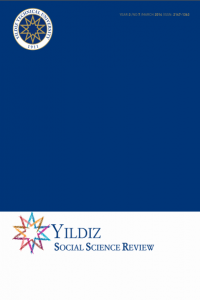Öz
Under the Fiscal Compact’s rules, the structural balance has become a crucial variable in the EU budgetary framework. This should facilitate the operativeness of the automatic stabilizers and avoid pro-cyclical fiscal policies . However, in the past years peripheral
member countries have witnessed a widespread budget restriction in front of a deep downturn of the economic cycle. We show that this occurred due to the distorted information provided by the model used by the European Commission to calculate the structural budget balance. Starting from the direct relationship between this latter and the NAWRU, we shed some light on the estimation methodology and its implication on member states’ fiscal policy. We focus our attention on the poor economic significance of the NAWRU and its large volatility over time. Finally, by the means of panel data estimations, we find out that the NAWRU is correlated with the economic cycle, which implies pro-cyclical effects on structural balances. Peripheral European countries seem to be more affected by these pro-cyclical effects than core countries.
Anahtar Kelimeler
Potential GDP Structural Balance Non-Accelerating Wage of Unemployment Fiscal Rules Austerity
Kaynakça
- Ball, L. M. (2009): “Hysteresis in Unemployment: Old and New Evidence,” Working Paper 14818, National Bureau of Economic Research.
- Blanchard, O., and L. F. Katz (1997): “What We Know and Do Not Know about the Natural Rate of Unemployment,” Journal of Economic Perspectives, 11(1), 51–72.
- Blanchard, O. J., and L. H. Summers (1986): “Hysteresis and the European Unemployment Problem,” Working Paper 1950, National Bureau of Economic Research.
- Estevao, M. M., and E. Tsounta (2011): “Has the Great Recession Raised U.S. Structural Unemployment?,” IMF Working Papers 11/105, International Monetary Fund.
- Estrella, A., and F. S. Mishkin (2000): “Rethinking the Role of NAIRU in Monetary Policy: Implications of Model Formulation and Uncertainty,” Working Paper 6518, National Bureau of Economic Research.
- Fantacone, S., P. Garalova, and C. Milani (2015): “Deficit strutturali e politiche di bilancio: i limiti del modello europeo,” Rivista di Politica Economica, 1(1).
- Friedman, M. (1968): “The Role of Monetary Policy,” American Economic Review, LVIII(1).
- Gianella, C., I. Koske, E. Rusticelli, and O. Chatal (2008): “What Drives the NAIRU? Evidence from a Panel of OECD Countries,” OECD Economics Department Working Papers 649, OECD Publishing.
- Gordon, R. J. (1997): “The Time-Varying NAIRU and Its Implications for Economic Policy,” Journal of Economic Perspectives, 11(1), 11–32.
- Modigliani, F., and L. Papademos (1975): “Targets for Monetary Policy in the Coming Year,” Brookings Papers on Economic Activity, 6(1), 141–166.
- Orlandi, F. (2012): “Structural unemployment and its determinants in the EU countries,” European Economy - Economic Papers 455, Directorate General Economic and Financial Affairs (DG ECFIN), European Commission.
- Phelps, E. S. (1968): “Money-Wage Dynamics and Labor-Market Equilibrium,” Journal of Political Economy, 76(4), 678–711.
- Stiglitz, J. (1997): “Reflections on the Natural Rate Hypothesis,” Journal of Economic Perspectives, 11(1), 3–10.
Öz
Kaynakça
- Ball, L. M. (2009): “Hysteresis in Unemployment: Old and New Evidence,” Working Paper 14818, National Bureau of Economic Research.
- Blanchard, O., and L. F. Katz (1997): “What We Know and Do Not Know about the Natural Rate of Unemployment,” Journal of Economic Perspectives, 11(1), 51–72.
- Blanchard, O. J., and L. H. Summers (1986): “Hysteresis and the European Unemployment Problem,” Working Paper 1950, National Bureau of Economic Research.
- Estevao, M. M., and E. Tsounta (2011): “Has the Great Recession Raised U.S. Structural Unemployment?,” IMF Working Papers 11/105, International Monetary Fund.
- Estrella, A., and F. S. Mishkin (2000): “Rethinking the Role of NAIRU in Monetary Policy: Implications of Model Formulation and Uncertainty,” Working Paper 6518, National Bureau of Economic Research.
- Fantacone, S., P. Garalova, and C. Milani (2015): “Deficit strutturali e politiche di bilancio: i limiti del modello europeo,” Rivista di Politica Economica, 1(1).
- Friedman, M. (1968): “The Role of Monetary Policy,” American Economic Review, LVIII(1).
- Gianella, C., I. Koske, E. Rusticelli, and O. Chatal (2008): “What Drives the NAIRU? Evidence from a Panel of OECD Countries,” OECD Economics Department Working Papers 649, OECD Publishing.
- Gordon, R. J. (1997): “The Time-Varying NAIRU and Its Implications for Economic Policy,” Journal of Economic Perspectives, 11(1), 11–32.
- Modigliani, F., and L. Papademos (1975): “Targets for Monetary Policy in the Coming Year,” Brookings Papers on Economic Activity, 6(1), 141–166.
- Orlandi, F. (2012): “Structural unemployment and its determinants in the EU countries,” European Economy - Economic Papers 455, Directorate General Economic and Financial Affairs (DG ECFIN), European Commission.
- Phelps, E. S. (1968): “Money-Wage Dynamics and Labor-Market Equilibrium,” Journal of Political Economy, 76(4), 678–711.
- Stiglitz, J. (1997): “Reflections on the Natural Rate Hypothesis,” Journal of Economic Perspectives, 11(1), 3–10.
Ayrıntılar
| Bölüm | Makaleler |
|---|---|
| Yazarlar | |
| Yayımlanma Tarihi | 11 Haziran 2016 |
| Yayımlandığı Sayı | Yıl 2015 Cilt: 1 Sayı: 2 |


